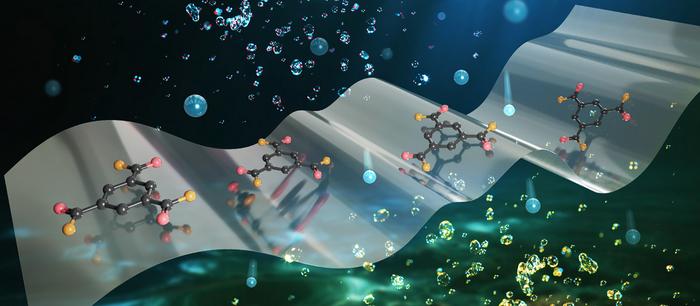In the realm of modern separation technologies, polymeric membranes have long held a prominent position due to their cost-effectiveness and adaptable fabrication processes. However, despite these advantages, traditional polymeric membranes face intrinsic limitations rooted in their microstructure. Unlike inorganic nanoporous materials such as metal-organic frameworks and covalent organic frameworks, which boast highly ordered and periodic channel architectures, conventional polymer membranes typically exhibit irregular pore configurations resulting from production methods like phase separation. This structural disorder restricts their capacity for precise molecular or ionic separation, especially when dealing with species of comparable size, thereby forcing a compromise between selectivity and permeability—a fundamental challenge in membrane science.
Recently, an interdisciplinary research team spearheaded by Professor LI Xianfeng from the Dalian Institute of Chemical Physics (DICP), under the Chinese Academy of Sciences, unveiled a groundbreaking strategy to overcome these longstanding hurdles. Their innovative approach hinges on an interfacial polymer cross-linking methodology designed to engineer ultra-thin polymeric membranes with nanoscale separation layers featuring quasi-ordered, angstrom-scale precision. Detailed in their latest publication in Nature Chemical Engineering, this technique fundamentally redefines membrane architecture by merging molecular-level cross-linking with controlled layer deposition, yielding structures that enable rapid yet selective ion transport.
At the heart of this innovation lies the transformation of polymer membranes into ultra-thin films with remarkably uniform and stable cross-linked networks. By meticulously orchestrating the interfacial polymerization and subsequent cross-linking reactions, the researchers succeeded in fabricating membranes as thin as 3 micrometers. This marked reduction in thickness is achieved without sacrificing mechanical robustness or operational stability, which are critical for practical deployment. The covalent cross-links formed between polymer chains create a quasi-ordered reticular matrix with well-defined cavities ranging between 1.8 and 5.4 angstroms, thus facilitating angstrom-level sieving capabilities hitherto scarcely attainable with traditional polymer membranes.
Precision control over the membrane’s morphology emerges from the variable parameters in the cross-linking process, such as reaction time and the choice of cross-linking agents. This tunability allows customization of pore size distribution and density, tailoring the membrane’s transport properties to target specific ion species. The result is a membrane that strikes an unprecedented balance, achieving both high ion selectivity and low resistance to ion flow. Such a breakthrough addresses the classic trade-off conundrum in membrane technology where improvements in selectivity often come at the cost of diminished permeability.
The implications of these ultra-thin cross-linked membranes extend strongly into the field of electrochemical energy storage, particularly in vanadium redox flow batteries (VRFBs). Integrating the newly developed membranes into VRFBs, the research team demonstrated operational current densities reaching 300 milliamperes per square centimeter—an exceptional performance metric indicative of enhanced ion transport kinetics. This heightened current density was accompanied by an impressive energy efficiency of 82.38%, underscoring the membrane’s capacity to facilitate rapid ion exchange while curbing undesirable ion crossover, which often plagues battery longevity and efficacy.
Underlying the superior performance is the membrane’s angstrom-scale sieving capability, which effectively discriminates between vanadium ions and charge-balancing species. The quasi-ordered reticular polymer network acts as a selective barrier, granting passage predominantly to target ions while impeding larger or undesired ionic species. This refined control over ion transport dynamics not only elevates battery efficiency but also addresses fundamental issues linked to membrane degradation and electrolyte contamination, promising extended device lifetimes and reduced maintenance costs.
From a mechanistic perspective, the interfacial cross-linking involves the formation of stable covalent bonds at the polymer interface, consolidating chains into a resilient network that resists swelling and mechanical deformation. This dimensional stability is pivotal for sustaining nanometer-scale separation channels under the dynamic operational stresses typical of electrochemical systems. Furthermore, the ultra-thin nature of the membranes drastically reduces ion transport resistance by shortening diffusion pathways, thereby accelerating charge transfer processes without compromising selectivity.
The simplicity and adaptability of this interfacial cross-linking strategy also open avenues for scalable manufacturing, a quintessential consideration for real-world applications. Unlike some elaborate inorganic frameworks requiring complex synthesis and processing, the polymeric membrane fabrication here can integrate with existing industrial techniques. This feasibility not only facilitates rapid prototyping and tuning but also paves the way towards the commercialization of high-performance membranes tailored for diverse separation challenges beyond energy storage, including water purification, gas separation, and chemical processing.
Professor LI underscores the broader ramifications of this study, emphasizing how these architectural and chemical insights transcend the specific domain of vanadium flow batteries. The design principles elucidated—nanoscale cross-linking, precise cavity control, and minimized membrane thickness—hold promise for the next generation of membrane-based technologies that demand simultaneous enhancements in selectivity, permeability, and mechanical durability. Consequently, these advances are poised to impact energy storage, environmental remediation, and chemical separations profoundly.
Moreover, by solving the classic selectivity-permeability dilemma, this work revitalizes interest in polymer membranes as versatile platforms for precision separations traditionally dominated by inorganic nanoporous materials. The marriage of polymer chemistry with nanoscale engineering manifests in membranes that deliver exceptional ionic sieving precision coupled with manufacturability and cost-effectiveness—the trifecta sought by researchers and industry alike.
In closing, this pioneering interfacial polymer cross-linking method heralds a paradigm shift in membrane fabrication, offering a compelling roadmap towards ultra-thin membranes with tailor-made structures that meet stringent demands across multiple sectors. As the scientific community continues to explore and refine such nanostructured materials, the intrinsic value of polymeric membranes is reaffirmed, not merely as economical alternatives, but as high-performance solutions capable of driving transformative advances in clean energy and beyond.
Article Title: Ultrathin membranes prepared through interfacial polymer cross-linking for selective and fast ion transport
Web References: 10.1038/s44286-025-00238-2
Image Credits: Dalian Institute of Chemical Physics (DICP)
Keywords
Batteries, Energy storage




